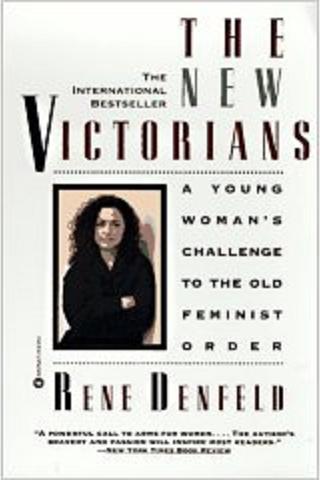The New Victorians
by Rene Denfeld
Allen & Unwin

"Conservatives are not going to align themselves with me", says Rene Denfeld. Despite this warning from the author, conservatives will indeed find much common ground with Denfeld's The New Victorians.
The New Victorians is a response from within to that most introspective of movements, feminism. Partly in answer to calls by "Old Guard" feminists for new young voices, 26-year-old Rene Denfeld attempts to explain feminism's lack of success in finding converts among younger women. Like Helen Garner's controversial The First Stone, The New Victorians sends a message regarding the state of contemporary feminism that older feminists find disconcerting and disappointing.
Denfeld explores the apparent paradox that while having benefited from feminism, young women are reluctant to apply the term to themselves. She rejects Susan Faludi's popular "backlash" theory as an explanation, laying the blame instead squarely at the feet of feminism itself. Described by one New York reviewer as "brave", Denfeld's book predictably has drawn outraged protest from the established feminist clique.
The "New Victorians" of the title are those whom Denfeld believes represent the current status quo in American feminism. On the evidence presented by Denfeld, the analogy is not as contradictory as it initially appears. Nor is Denfeld anti-feminist. While she proudly adopts the term, she is disappointed by some elements of contemporary feminism in the United States.
IRRELEVANT
Denfeld complains that "feminism has changed -- dramatically", to become on the whole a movement that is extremist and radical, and irrelevant to most young women. Claiming that feminism has moved away from the fundamental issues of equality to embrace extreme moralising and exclusive academic theorising, Denfeld writes that "feminism has become as confining as what it pretends to combat".
This is not entirely convincing. For while feminism, like most social movements, is an evolving being, it has always been radical and, at times, less than inclusive. While Denfeld spends considerable time showing exactly how radical and exclusive feminism is today, there is little to back the argument that this is a relatively recent change, one unique to the 1990s. The radical aspects of feminism that Denfeld uses to illustrate her point have largely been with the Movement since its inception, in one form or another.
One notable exception to this is the trend toward goddess worship, to which Denfeld devotes one chapter. This is a new phenomenon, but it has little if any currency in Australia and shows little chance of gaining credibility in local, established feminist circles.
Despite these reservations, much of Denfeld's book appears to speak for the young -- and not so young -- women of my acquaintance who have expressed doubts about organised feminism's appeal and applicability to them.
But is this enough on which to base a book? For while Denfeld makes extensive use of surveys and studies which show the rejection of feminism, her evidence of why this is occurring is much less firm. In this regard, she relies too heavily on anecdotal evidence, with several references to the same named interviewees, and only a few brief words of thanks in the book's opening pages to "all the young women, too numerous to name here, who were willing to talk to me openly and honestly about their feelings regarding feminism" to let the reader know on what Denfeld based her conclusions.
Similarly, Denfeld's survey of contemporary feminism relies too heavily on feminism in universities. "Young women are far more likely to encounter organised feminism by taking an introductory women's studies course, attending rallies on campuses, picking up the latest issue Ms magazine, reading newspaper accounts, and browsing in the feminist literature section of bookstores", she writes.
Unfortunately, Denfeld gives little emphasis to "reading newspaper accounts" or indeed to other aspects of popular culture's reaction to feminism, except when it proves a negative point. Her attention to academia ignores the fact that most people, and most women, don't have a university education, and if they do, they are unlikely to have taken classes in women's studies or to have taken more than a passing interest in a "women's rally". Perhaps Denfeld gives too much credibility to the impact of university feminists on the world beyond campus.
EXTREMISTS
Similarly, she highlights the views of extremists within feminism, such as Andrea Dworkin, claiming that Dworkin's radical offerings are commonplace on university reading lists, and are offered as mainstream feminism. Again, Dworkin's views arguably have little currency beyond academic, philosophical or feminist circles. While I have not surveyed women's studies courses in Australia, as Denfeld apparently has in the US, I can report that, according to the university calendar, Dworkin's work has not appeared on the Monash University women's studies reading lists in the last few years.
The crux of Denfeld's arguments is in Chapter Seven, "Repeating History: The Feminist Descent into Victorian Morality". In this highly detailed chapter, she draws parallels between the puritanical Victorians and their obsessive protection of women and the feminists of the 1990s. "The movement that once stood for equality for all women", she writes, "has come to stand instead for extremist and often irrelevant academic theories and the patronising views held by an elitist group of largely privileged women".
This is manifest in the efforts of contemporary feminists to convince women that sexuality is "abnormal if not physically dangerous", and that females are "above" the "masculine" characteristics of competition, aggression, lust and strength. Above all, the new Victorians have embraced the "Victorian declaration of difference", meaning that women, unlike men, are sensitive, nurturing, magical beings. Denfeld identifies this as being most obvious through the rise of goddess worship, the blaming of patriarchy for all ills and the categorisation of women as victims ("the passive voice"). She labels these new directions a waste of time, damaging to feminism and irrelevant to the real issues that matter to most women.
Denfeld spends less time theorising about how exactly feminism has reached this predicament, concluding that, in essence, the potential to go off the rails was always there due to feminism's fragmentation. The failure in the 1980s of the US Equal Rights Amendment (ERA) to pass marked another blow, which left a directional void within the movement. New leaders and new causes sprang up to occupy this void, but they were out of touch with real women.
Denfeld also targets the conservatism of the Reagan and Bush administrations, a lack of tolerance of different views within feminism, and a reluctance among older feminists to admit that feminism has changed from the 1970s. Above all, she claims, older feminists will not admit that being feminist is about living what you believe -- and if this is the case, then most young women are feminists whether they say it or not.
This rationale for the decline of organised feminism does not neatly transfer to the Australian context. Most glaringly, we did not have a conservative government during most of the 1980s, nor did Australian feminists suffer the legislative setbacks that the ERA failure represented to their American counterparts.
The New Victorians is a largely retrospective book with little attention given to the ongoing issues of feminism. These are tackled only in the book's closing pages: childcare, birth control, abortion rights, "political parity" and sexual violence. "Political parity", or the need for more women in government, is given a scant seventeen-and-a-half lines. In closing, Denfeld urges us to oppose censorship and "dump women's studies programs".
The New Victorians provides a selective and, in large part, anecdotal account of the contemporary American feminist scene. Despite a foreword by Beatrice Faust, much of it lacks direct applicability to Australia (other than in the ways I have identified in this review). The book is largely retrospective and thus short on prescriptian or future directions. Despite these reservations, Denfeld's words will undoubtedly strike a chord with those who are fed up with organised feminism's apparently all-consuming navel-gazing, and its lack of relevance to young women.

